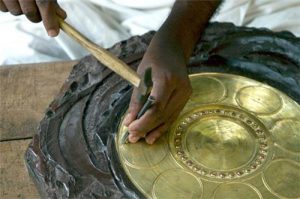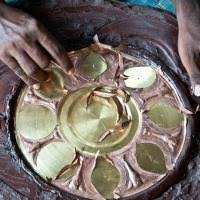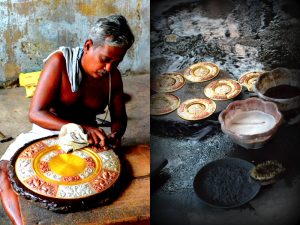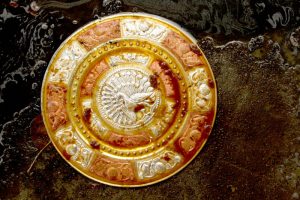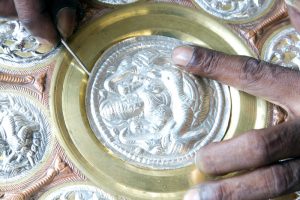Thanjavur Art Plate
The Thanjavur Art Plate are the gift items generally seen in our childhood. These art plates are exclusively made in Thanjavur, Tamil Nadu, India. It is a circular plate used as a gift item,
wall hanging, and decorative pieces. These are made with metals like copper, silver, brass, and gauge wax.
The artwork has been registered for protection under the Geographical indication of the Trade-Related Intellectual Property Rights (TRIPS) agreement.
It is listed in item 63 as “Thanjavur Art Plate” of the GI Act 1999 of the Government of India, with registration confirmed by the Controller General of Patents Designs and Trademarks.
Only the size of the article is permitted to be different while other metal compositions and particularization have to remain the same as per GI approval.
THANJAVUR ART PLATE RAW MATERIALS
The raw materials used for art plates are Brass and copper sheets (for platting), silver and copper sheets (for embedding the design) and gauge wax.
THANJAVUR ART PLATE HISTORY
Though there are many theories about who introduced the art plate, the main one was that it was introduced by Rajah Serfoji-II during the Maratha rule in Thanjavur. These plates are made by the community of Vishwakarma’s, which consists of few goldsmith families of Thanjavur.
THANJAVUR ART PLATE PRODUCTION
Initially, the sheet is pressed with the molding machine to attain a plate-like shape.
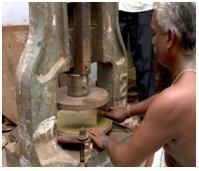
The plate is then gently beaten with the hammer to obtain depth.
Once it is beaten the metal plate is filled with burning charcoal and fixed on a wooden base over the lac. Due to heat generated by the metal sheet, the lac melts and allows the plate to be fixed on it.
The artisan now starts the engraving work on the plate by marking the design. The center part of the plate is decorated with circular bowl-shaped beads which are made of copper and brass.
Embossing work is done separately with thin copper and metal sheets. These sheets are placed over the moulds and gently beaten into the grooves. Once the sheet takes the shape and design of mould, then it is filled with natural glue and melted.
These designed silver and copper sheets are fixed on the brass metal sheet. The art plate is embellished in floral and Hindu mythological motifs.
The plate is finally cleaned with a mixture made of tamarind, soapnut and coal powder to attain shine and luster. After washing, the plate is kept for drying.


